MaryAnn Bernal's Blog, page 51
July 16, 2017
Scientists Learn Ingredients of 2,000-Year-Old Roman Pills Found in Ancient Shipwreck
Ancient Origins
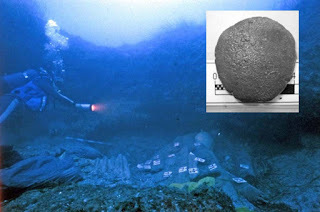
Discoveries of ancient shipwrecks are always exciting, but a small number of them are truly unique in the artifacts they yield, offering up items from the past that have been preserved for centuries at the bottom of the sea. The finding of a 2,000-year-old Roman shipwreck, known as the Relitto del Pozzino, which had sunk off the coast of Tuscany in Italy was one of these cases. Tucked away safely inside a sealed tin, were 5 perfectly preserved medicinal pills.
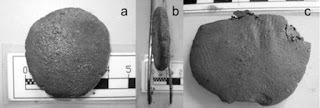
A front, profile, and rear view of one of the medicinal tablets. Image via PNAS/Giachi et. al.
Discovery of the Ancient Wreck
The Relitto del Pozzino wreck was found near the remains of Populonia, an Etruscan city which served as a key port along trade routes operating between the west and the east of the Mediterranean Sea. Eventually, the Romans seized the entire coastline and ejected the Etruscans from it.
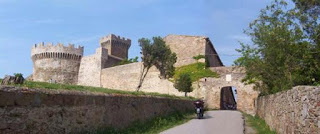
Main gate of Populonia (public domain)
A Rich Trove of Artifacts
First discovered in the 1980s, the shipwreck excited researchers with its rich trove of artifacts, including bronze jugs, lamps from Asia minor, Syrian-Palestinian glass bowls, and wine vessels. But one of the most fascinating relics was an ancient medicine chest containing 136 wooden drug vials, a surgery hook, a mortar and several tin vessels, known as pyxides. Scientists were astounded to find that the tins were still sealed and had preserved their contents over two millennia. They now had a unique opportunity to learn the contents of Roman medicines.
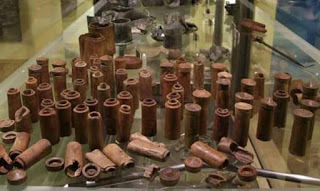
The wooden drug vials found on the Relitto del Pozzino shipwreck (Not Only Chemistry)
Analyzing the Pills
Several years ago, a research team undertook a chemical analysis of the 5 medicinal pills that were found in one of the tins and published their findings in the journal Proceedings of the National Academy of Sciences.
Tests revealed that the pills were composed of zinc compounds, iron oxide, starch, beeswax, pine resin and other plant-derived materials. By consulting with physicians and turning to historical records of ancient medicines, the researchers concluded that the pills were used as a type of eye medicine.
The discovery offered a rare glimpse into the medical treatments used in ancient Rome.
Top image: Main: A diver searches the Relitto del Pozzino shipwreck (Not Only Chemistry). Inset: One of the medicinal tablets. Image via PNAS/Giachi et. al.
By April Holloway
Published on July 16, 2017 01:30
July 15, 2017
The Story of Sif, Powerful Wife of Norse God Thor
Ancient Origins

The warrior god Thor is well known from Old Norse literature. He has become a popular cultural icon, but his wife seems to be largely forgotten these days. However, Sif was once recognized as an important Norse goddess and a powerful ''neck, which ruled the head''.
A Goddess of Wheat, Fertility, and Family
Sif is known as a Norse deity whose powerful position was dictated by her marriage. She appears in the Poetic Edda and Prose Edda, which are the best known 13th century traditional sources on Norse mthyology.
In these texts, Sif appears as a beautiful woman with long golden hair. She was described as the mother of the goddess Thrúd (meaning ''Might'', a goddess of the storm), and god Ullr (meaning ''The Magnificent'', a god of winter). Researchers suggest that she represented the fields of wheat, which had a golden color similar to her hair.
Since the beginning, Sif was associated with fertility and family caregiving, and she was connected to the rowan tree. Her name means ''relation to marriage''. She may also be represented in the Old English poem Beowulf. The number of references of the goddess suggests that she was very important to the Norse people until at least the early medieval period.
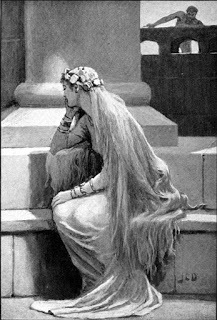
Sif (1909) by John Charles Dollman. (Public Domain)
The Legend of Sif
The story in both Edda's about Sif is similar. She appears in the poem Hárbarðsljóð, of the Poetic Edda, where she meets Thor. They two engage, but Harbaror refuses to ferry Thor to the bay. The action of the poem contains many insults from Thor. Harbaror punishes him by telling him that Sif has a lover. Thor gets angry, but tells his enemy that it's a lie.
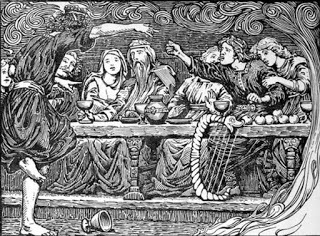
Image from The Elder or Poetic Edda. (Public Domain)
In another part, Sif appears in a scene with Loki, another Norse god. It's a scene related to the crystal cup of mead, but also provides an example of Loki’s personality, as the god lies by swearing that Sif had a romance with him.
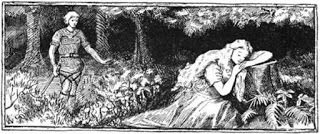
Sif sleeps while Loki lurks behind in an illustration (1894) by A. Chase. (Public Domain)
In the Prose Edda, Sif appears in the Prologue section and in chapter 31 of Gylfaginning, but also in a few more places. Analysis of these texts reminds one of reading an old alphabet in the dark, but some researchers have made interesting conclusions about her based on these accounts. According to Ellis Davidson, there are some explanations about her position in the pantheon of Norse deities:
''The cult of Thor was linked up with men's habitation and possessions, and with well-being of the family and community. This included the fruitfulness of the fields, and Thor, although pictured primarily as a storm god in the myths, was also concerned with the fertility and preservation of the seasonal round. In our own times, little stone axes from the distant past have been used as fertility symbols and placed by the farmer in the holes made by the drill to receive the first seed of spring. Thor's marriage with Sif of the golden hair, about which we hear little in the myths, seems to be a memory of the ancient symbol of divine marriage between sky god and earth goddess, when he comes to earth in the thunderstorm and the storm brings the rain which makes the fields fertile. In this way Thor, as well as Odin, may be seen to continue the cult of the sky god which was known in the Bronze Age.''
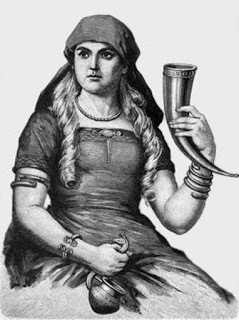
Sif from a Swedish translation of the Edda. (Public Domain)
Thor was her second husband; the first one was the Giant Orvandil. Sif seems to be a similar goddess to Freya, Fjorgyn, Jord and Gefjun. It is likely that the legends about these deities were inspired by each other. She was also sort of a Norse Demeter, who was associated with vegetation on the surface of the earth, as well as fertility.
Moreover, Sif is depicted as a prophetess who knew and could see more than those around her. She was believed to be a goddess who helped others to find solutions and peace in difficult times. It was once tradition for people to bake breads with many grains to honor this goddess and ask for her help.
A Goddess for All Times
Other themes associated with Sif are: kinship, the arts, summer, passion, and the sun. In iconography, her symbols are gold, a beautiful female with golden cascading hair, and the sun. She was an Earth goddess, whose long golden hair was described as shining brighter than the sun.
Sif was also able to dominate the sky with her light. Moreover, during the summer she supposedly liked to make love to Thor beneath the open sky in the fields. Sometimes people would say that if they heard a couple making love in such a place it could have been Sif with Thor, so they didn't disturb them.
The Norse people of Iceland always greet the first day of the summer with much joy and gratitude. It seems that Sif (as an Earth Goddess) played an important role in this celebration.
In the 19th century, a researcher named Jacob Green wrote about Sif in his works, bringing her back to Scandinavian folklore. Her popularity rose with the resurgence of past folklore and the rise in the importance of old traditions and beliefs. Since Thor's temple has started to become a new reality in Iceland, his wife is also becoming one of the most popular deities of the Norse religion.
Sif became a main character of the Marvel Comics and in the movie Thor by Marvel Studios as well. Her name was also used to name a volcano on the planet Venus – the Sif Mons.

Artwork for the cover of Thor: Son of Asgard 3 (Jun, 2004). Art by Adi Granov. (Fair Use)
Top image: A depiction of the Norse goddess Sif. Source: Journeying to the Goddess
By Natalia Klimczak

The warrior god Thor is well known from Old Norse literature. He has become a popular cultural icon, but his wife seems to be largely forgotten these days. However, Sif was once recognized as an important Norse goddess and a powerful ''neck, which ruled the head''.
A Goddess of Wheat, Fertility, and Family
Sif is known as a Norse deity whose powerful position was dictated by her marriage. She appears in the Poetic Edda and Prose Edda, which are the best known 13th century traditional sources on Norse mthyology.
In these texts, Sif appears as a beautiful woman with long golden hair. She was described as the mother of the goddess Thrúd (meaning ''Might'', a goddess of the storm), and god Ullr (meaning ''The Magnificent'', a god of winter). Researchers suggest that she represented the fields of wheat, which had a golden color similar to her hair.
Since the beginning, Sif was associated with fertility and family caregiving, and she was connected to the rowan tree. Her name means ''relation to marriage''. She may also be represented in the Old English poem Beowulf. The number of references of the goddess suggests that she was very important to the Norse people until at least the early medieval period.

Sif (1909) by John Charles Dollman. (Public Domain)
The Legend of Sif
The story in both Edda's about Sif is similar. She appears in the poem Hárbarðsljóð, of the Poetic Edda, where she meets Thor. They two engage, but Harbaror refuses to ferry Thor to the bay. The action of the poem contains many insults from Thor. Harbaror punishes him by telling him that Sif has a lover. Thor gets angry, but tells his enemy that it's a lie.

Image from The Elder or Poetic Edda. (Public Domain)
In another part, Sif appears in a scene with Loki, another Norse god. It's a scene related to the crystal cup of mead, but also provides an example of Loki’s personality, as the god lies by swearing that Sif had a romance with him.

Sif sleeps while Loki lurks behind in an illustration (1894) by A. Chase. (Public Domain)
In the Prose Edda, Sif appears in the Prologue section and in chapter 31 of Gylfaginning, but also in a few more places. Analysis of these texts reminds one of reading an old alphabet in the dark, but some researchers have made interesting conclusions about her based on these accounts. According to Ellis Davidson, there are some explanations about her position in the pantheon of Norse deities:
''The cult of Thor was linked up with men's habitation and possessions, and with well-being of the family and community. This included the fruitfulness of the fields, and Thor, although pictured primarily as a storm god in the myths, was also concerned with the fertility and preservation of the seasonal round. In our own times, little stone axes from the distant past have been used as fertility symbols and placed by the farmer in the holes made by the drill to receive the first seed of spring. Thor's marriage with Sif of the golden hair, about which we hear little in the myths, seems to be a memory of the ancient symbol of divine marriage between sky god and earth goddess, when he comes to earth in the thunderstorm and the storm brings the rain which makes the fields fertile. In this way Thor, as well as Odin, may be seen to continue the cult of the sky god which was known in the Bronze Age.''

Sif from a Swedish translation of the Edda. (Public Domain)
Thor was her second husband; the first one was the Giant Orvandil. Sif seems to be a similar goddess to Freya, Fjorgyn, Jord and Gefjun. It is likely that the legends about these deities were inspired by each other. She was also sort of a Norse Demeter, who was associated with vegetation on the surface of the earth, as well as fertility.
Moreover, Sif is depicted as a prophetess who knew and could see more than those around her. She was believed to be a goddess who helped others to find solutions and peace in difficult times. It was once tradition for people to bake breads with many grains to honor this goddess and ask for her help.
A Goddess for All Times
Other themes associated with Sif are: kinship, the arts, summer, passion, and the sun. In iconography, her symbols are gold, a beautiful female with golden cascading hair, and the sun. She was an Earth goddess, whose long golden hair was described as shining brighter than the sun.
Sif was also able to dominate the sky with her light. Moreover, during the summer she supposedly liked to make love to Thor beneath the open sky in the fields. Sometimes people would say that if they heard a couple making love in such a place it could have been Sif with Thor, so they didn't disturb them.
The Norse people of Iceland always greet the first day of the summer with much joy and gratitude. It seems that Sif (as an Earth Goddess) played an important role in this celebration.
In the 19th century, a researcher named Jacob Green wrote about Sif in his works, bringing her back to Scandinavian folklore. Her popularity rose with the resurgence of past folklore and the rise in the importance of old traditions and beliefs. Since Thor's temple has started to become a new reality in Iceland, his wife is also becoming one of the most popular deities of the Norse religion.
Sif became a main character of the Marvel Comics and in the movie Thor by Marvel Studios as well. Her name was also used to name a volcano on the planet Venus – the Sif Mons.

Artwork for the cover of Thor: Son of Asgard 3 (Jun, 2004). Art by Adi Granov. (Fair Use)
Top image: A depiction of the Norse goddess Sif. Source: Journeying to the Goddess
By Natalia Klimczak
Published on July 15, 2017 02:00
July 14, 2017
10 Secrets About Ancient Greece That Are Rarely Recounted
Ancient Origins
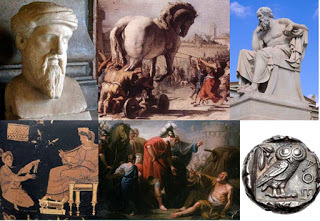
The ancient Greeks have contributed so much to modern civilization, especially regarding education, philosophy, science, art, politics, and language, among other things. But, their legacy does not end there. One of the most enduring things about ancient Greece is the mythology. Zeus, Minotaur, Hercules, Achilles, Prometheus… The list is virtually endless. But, while it’s a given that most myths are fiction for the most part, have you ever wondered if there is any truth in the stories? I have, and after doing my homework, here is a list of 10 secrets about Greek mythology and Ancient Greece that have only been revealed fairly recently.
1. The Trojan Horse Didn’t Really Exist
We are all familiar with the story of the Trojan Horse from Homer’s Odyssey, but it turns out that the legendary wooden horse that was used to sneak into Troy is indeed a myth. While there are no doubts about Troy being a real city which was really burned to the ground by the Greeks, there is no archaeological evidence to support the existence of the Trojan Horse, which is the source of the myth. It was probably inspired by the fact that most armies were using damp horse hides to protect themselves from flaming arrows during sieges.
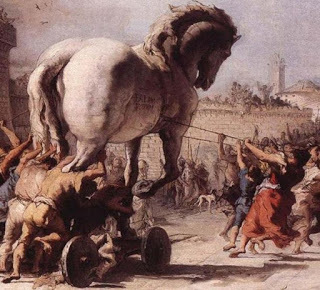
The Procession of the Trojan Horse in Troy.’ (Public Domain)
Although it looks impressive, there was no real Trojan Horse.
2. There is No Proof that Homer Existed
In addition to some of his biggest epics being a myth, we cannot say for sure that Homer himself existed. To be more accurate, there is no written proof about Homer ever existing - which isn’t to say for sure that he didn’t either. The problem is that Greek epics and legends were passed on orally for centuries, before someone remembered to write them down, which means it’s hard to prove that Homer had existed and written all those epics.
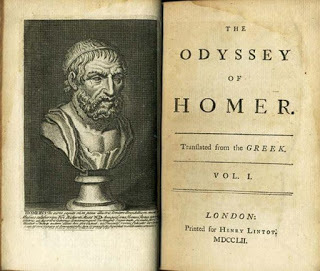
Frontispiece and Titlepage of a 1752 edition of Alexander's Pope's translation of The Odyssey. (Public Domain)
3. Pythagoras May Not Have Invented the Theorem Bearing His Name
Again, there is no written evidence that Pythagoras came up with his famous equation. But, there is evidence that the Babylonians were using the theorem to do calculations a few centuries before. Pythagoras was a brilliant mathematician nonetheless and was the first one to use ratios in order to explain music intervals.
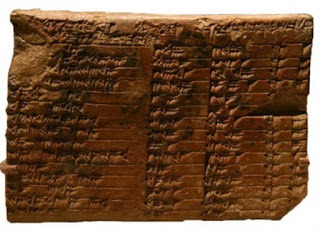
Old Babylonian clay tablet (known as Plimpton 322) stores combination of primitive Pythagorean triples. Babylonians knew of the ‘Pythagorean’ theorem. (Luis Teia)
4. Spartans Didn’t Use Iron as Currency
Although it fits in well with the whole Spartan mythology and their image as hardened warriors, Spartans did not actually use iron as currency. In fact, no coins were ever actually made in Sparta. Instead, they used foreign silver. Apart from that, there was no import of luxury goods into Sparta, as it would alter the way they led their lives, which consisted of rigorous training regimes, war, dieting, and of course, using laconic expressions, for which they are known the most.
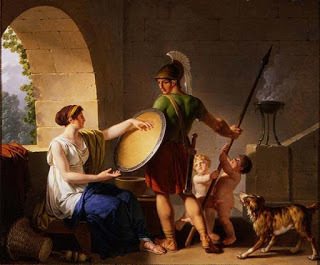
‘A spartan woman giving a shield to her son’ by Jean-Jacques-Francois Le Barbier. (Public Domain) Spartans weren’t all about iron money.
5. The Greek Alphabet Didn’t Have Just One Inventor
One of the first works that was ever written down using the Greek alphabet was the Homeric epics - dating as far back as the 8th century BC. The Greek alphabet actually used the Phoenician alphabet as a basis. The first two letters of the aforementioned alphabet were aleph and bet, hence the name. According to ancient Greeks, Palamedes was the one who invented the Greek version, but surprisingly, it was the Pythagoras who gave the letters their distinct geometrical shapes they are famous for.
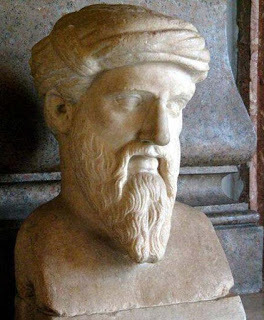
Pythagoras helped shape the Greek alphabet. (CC BY SA 3.0)
6. Greeks Started Using Money Because of Their Psyche
Needless to say, when it first appeared, money made things a lot easier. However, trade was not the reason why Greeks started using currency and coins in the 5th century BC. They did it because the idea of reciprocation and obligation to their fellow men that was deeply ingrained into their society and psyche.
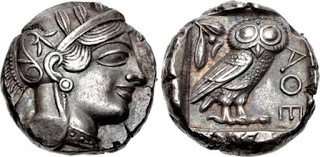
454-404 BC Attica, Athens. Tetradrachm. Helmeted head of Athena right / ΑΘΕ, owl standing right; olive-sprig and crescent above. (Classical Numismatic Group, Inc./CC BY SA 3.0) Greek money came about due to reciprocity and obligation.
7. Theaters Were a Part of the Cult of Dionysus
There is no doubt that the great Greek tragedies and comedies performed at the Acropolis were a part of the cult of Dionysus. But, there has been a lot of debate about the origins of theater itself. According to some sources, it started with the actor Thespis, because of whom we use the word “thespian”, who performed his roles standing on a cart almost a century earlier.
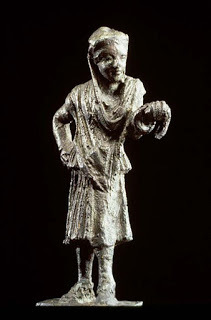
The half-mask over the eyes and nose identifies the figure as an actor. He wears a man's conical cap but female garments, following the Greek custom of men playing the roles of women. (Public Domain) Did Greek theater come about thanks to a man who stood on a cart?
8. Socrates Was a Warrior before He Became a Philosopher
Even though Socrates is primarily known for his legacy as a thinker and a philosopher, he was actually an experienced warrior who survived grueling military campaigns - during which he even performed heroic acts. It was his experience in the military that made him think about life. He spent the rest of his life trying to educate his fellow Greeks and get them to think about their own lives.
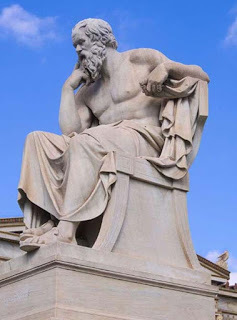
Statue of Socrates – warrior turned philosopher. (C Messier/CC BY SA 4.0 )
9. The Secrets of Greek Cults Remain Secret
We've already mentioned the cult of Dionysus, but there were other cults, most notably the cult of Demeter, who was a goddess of agriculture. Not much is known about what actually went on during the ceremonies. It is speculated that the initiations involved wearing ritual clothing and worshiping different objects so that initiates would be permitted with a glimpse of the afterlife.
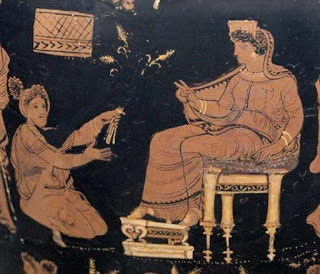
Demeter, enthroned and extending her hand in a benediction toward the kneeling Metaneira who offers the triune wheat that is a recurring symbol of the mysteries (Public Domain) The cult of Demeter was just one mysterious group in ancient Greece.
10. Alexander the Great Was Not That Great
We are not trying to take away anything from his military prowess, which is legendary and accurate. But, his stature was short and Alexander was not known for being disciplined. He drank and had a bad temper, and there are plenty of his companions that wound up on the receiving end of his tantrums. Later in life, he became paranoid. However, his legacy as a famous military leader remains untouched.
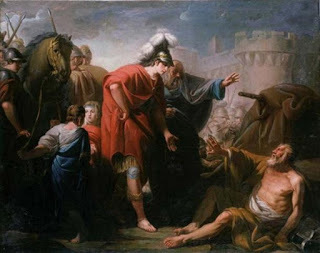
The meeting between Alexander and Diogenes (Public Domain) Alexander the Great was rather short, angry, paranoid, and somewhat undisciplined.
Top Image: Bust of Pythagoras. (CC BY SA 3.0), ‘The Procession of the Trojan Horse in Troy.’ (Public Domain), Statue of Socrates – warrior turned philosopher. (C Messier/CC BY SA 4.0), Demeter, enthroned and extending her hand in a benediction toward the kneeling Metaneira (Public Domain), The meeting between Alexander and Diogenes (Public Domain), and Tetradrachm. ΑΘΕ, owl standing right; olive-sprig and crescent above. (Classical Numismatic Group, Inc./CC BY SA 3.0)
By Mia Stokes
Published on July 14, 2017 01:30
July 13, 2017
Is this the Final Resting Place of Noah? It is Certainly One of the Contenders
Ancient Origins
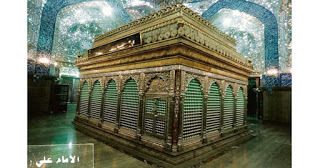
The tale about a huge ship (of Biblical proportions) that enabled the survival of all of the species of animals around the world sounds impressive, but also quite unbelievable. Nonetheless, its builder, Noah, is one of the most popular biblical figures. Furthermore, he is an important prophet in Islam. Although his story, perhaps inspired by the Epic of Gilgamesh, has existed for thousands of years and is known by billions of people, the place of Noah’s burial remains unknown.
Around the world, people in their first years of life learn the story of a man who saved many people and animal species from death under the waters that came with a horrible flood. The ‘Ark’ story, known since ancient times, became so popular that it is a world-famous myth known in most of the cultures long before its iteration as part of the Bible. However, most of the stories related to Noah are nothing more than oral history.
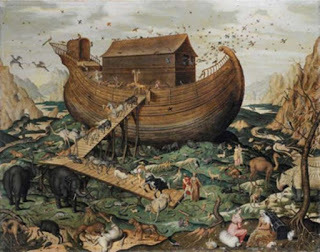
Noah's ark on the Mount Ararat, Simon de Myle, 1570. (Public Domain)
A Sailor Named Noah
Apart from the biblical notes and the information that comes from other descriptions of a similar flood (like the Epic of Gilgamesh), no information can provide identifying personal data about Noah. Religious people believe that Noah lived for about 950 years. This number appears among the believers of modern religions. Moreover, it is confirmed by the Bible. According to the Book of Genesis:
''20 And Noah began to be an husbandman, and he planted a vineyard: 21 And he drank of the wine, and was drunken; and he was uncovered within his tent. 22 And Ham, the father of Canaan, saw the nakedness of his father, and told his two brethren without. 23 And Shem and Japheth took a garment, and laid it upon both their shoulders, and went backward, and covered the nakedness of their father; and their faces were backward, and they saw not their father's nakedness. 24 And Noah awoke from his wine, and knew what his younger son had done unto him. 25 And he said, Cursed be Canaan; a servant of servants shall he be unto his brethren. 26 And he said, Blessed be the Lord God of Shem; and Canaan shall be his servant. 27 God shall enlarge Japheth, and he shall dwell in the tents of Shem; and Canaan shall be his servant. 28 And Noah lived after the flood three hundred and fifty years. 29 And all the days of Noah were nine hundred and fifty years: and he died.''
Sadly, there is no historical source, apart from the religious texts, which confirms this data from the biography of Noah. Moreover, through the ages dozens of researchers (some more, some less professional) have tried to prove their own ideas about the possible biography of this legendary man. One of the most credible pieces of research was accomplished by the team led by Robert D. Ballard. His goal was to explain the biblical flood in a scientific way.
From Shipwreck to Tomb: The Rival Claims The most famous story says that the famous Ark ended its voyage on the slopes of Mount Ararat, now in eastern Turkey (but for a very long time in Armenia). The importance of this claim is based on a religious issue, as Islam dominates Turkey and Armenia has always been related to Christianity. Furthermore, one of the possible tombs of Noah is located in territory contested by Armenia and Azerbaijan.
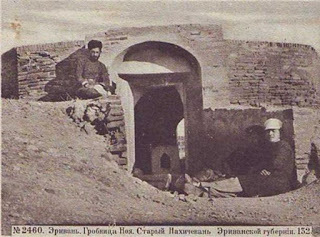
Noah's Tomb or Mausoleum in Nakhchivan, Postcard, circa 1917. (Public Domain)
The mausoleum located in Nakhchivan is located on the land known as Kohna-gala, meaning ''Old fortress''. Many Armenians believe that this is traditionally their territory, but currently, it officially belongs to Azerbaijan. The construction was built around the 8th century AD, but could possibly be a little younger.
It was rebuilt many times and now the main building contains the remnants of the former one. Inside the burial chamber there is a column and according to the explanations presented by guides, this is the place where the relic of Noah was buried. Thus, it seems that even the locals don't see the mausoleum as the original burial place of Noah, just a temple for a relic deposit.
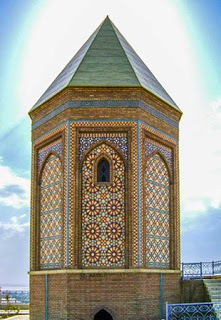
17th century Noah Mausoleum, Nakhchivan, Azerbaijan. (Public Domain)
The Imam Ali Mosque in Najaf, Iraq, is a destination for the pilgrimage of millions of people every year. The average number of pilgrims is about 8 million people. It is a holy site for Muslims who follow the Shia belief (the ones who accept that Muhammad had an ancestor – Ali ibn Abi Talib). The followers of this faith believe that Ali was buried next to the legendary Adam and Noah
There is also a folklore story in the city of Cizre in Turkey and Karak Nuh in Lebanon. The tradition from Cizre claims that it was the original burial place of Noah and his family. However, neither the Iraqi or Turkish theory can be confirmed. In the case of Lebanon, it is commonly said that it was the relics that were buried in this place.

Noah's Coffin inside Noah Mausoleum in the city of Cizre, Turkey. (CC BY-SA 3.0)
Legends Are Stronger than Reality
The story about the tomb of Noah is full of mysteries. Although religious circles believe that they know the real burial place of the legendary sailor, the number of possible grave locations creates doubt in the story.
Apart from the stories from the Middle East and other Muslim countries, there is one more legendary location to add to the confusion. In north-west Spain in Galicia there is a town named Noia. Its name comes from the biblical Noah and the coat of arms of the town has the image of the famous ark. Although historians speak with one voice that the legend has no credit in resources, the story stays a popular element of local folklore.
Top Image: Imam Ali Mosque - Shrine of: 1st Shia Imam - Ali ibn abi Talib; Prophet Adam; and Prophet Nuh (Noah). Najaf, Iraq. Source: Public Domain
By Natalia Klimczak

The tale about a huge ship (of Biblical proportions) that enabled the survival of all of the species of animals around the world sounds impressive, but also quite unbelievable. Nonetheless, its builder, Noah, is one of the most popular biblical figures. Furthermore, he is an important prophet in Islam. Although his story, perhaps inspired by the Epic of Gilgamesh, has existed for thousands of years and is known by billions of people, the place of Noah’s burial remains unknown.
Around the world, people in their first years of life learn the story of a man who saved many people and animal species from death under the waters that came with a horrible flood. The ‘Ark’ story, known since ancient times, became so popular that it is a world-famous myth known in most of the cultures long before its iteration as part of the Bible. However, most of the stories related to Noah are nothing more than oral history.

Noah's ark on the Mount Ararat, Simon de Myle, 1570. (Public Domain)
A Sailor Named Noah
Apart from the biblical notes and the information that comes from other descriptions of a similar flood (like the Epic of Gilgamesh), no information can provide identifying personal data about Noah. Religious people believe that Noah lived for about 950 years. This number appears among the believers of modern religions. Moreover, it is confirmed by the Bible. According to the Book of Genesis:
''20 And Noah began to be an husbandman, and he planted a vineyard: 21 And he drank of the wine, and was drunken; and he was uncovered within his tent. 22 And Ham, the father of Canaan, saw the nakedness of his father, and told his two brethren without. 23 And Shem and Japheth took a garment, and laid it upon both their shoulders, and went backward, and covered the nakedness of their father; and their faces were backward, and they saw not their father's nakedness. 24 And Noah awoke from his wine, and knew what his younger son had done unto him. 25 And he said, Cursed be Canaan; a servant of servants shall he be unto his brethren. 26 And he said, Blessed be the Lord God of Shem; and Canaan shall be his servant. 27 God shall enlarge Japheth, and he shall dwell in the tents of Shem; and Canaan shall be his servant. 28 And Noah lived after the flood three hundred and fifty years. 29 And all the days of Noah were nine hundred and fifty years: and he died.''
Sadly, there is no historical source, apart from the religious texts, which confirms this data from the biography of Noah. Moreover, through the ages dozens of researchers (some more, some less professional) have tried to prove their own ideas about the possible biography of this legendary man. One of the most credible pieces of research was accomplished by the team led by Robert D. Ballard. His goal was to explain the biblical flood in a scientific way.
From Shipwreck to Tomb: The Rival Claims The most famous story says that the famous Ark ended its voyage on the slopes of Mount Ararat, now in eastern Turkey (but for a very long time in Armenia). The importance of this claim is based on a religious issue, as Islam dominates Turkey and Armenia has always been related to Christianity. Furthermore, one of the possible tombs of Noah is located in territory contested by Armenia and Azerbaijan.

Noah's Tomb or Mausoleum in Nakhchivan, Postcard, circa 1917. (Public Domain)
The mausoleum located in Nakhchivan is located on the land known as Kohna-gala, meaning ''Old fortress''. Many Armenians believe that this is traditionally their territory, but currently, it officially belongs to Azerbaijan. The construction was built around the 8th century AD, but could possibly be a little younger.
It was rebuilt many times and now the main building contains the remnants of the former one. Inside the burial chamber there is a column and according to the explanations presented by guides, this is the place where the relic of Noah was buried. Thus, it seems that even the locals don't see the mausoleum as the original burial place of Noah, just a temple for a relic deposit.

17th century Noah Mausoleum, Nakhchivan, Azerbaijan. (Public Domain)
The Imam Ali Mosque in Najaf, Iraq, is a destination for the pilgrimage of millions of people every year. The average number of pilgrims is about 8 million people. It is a holy site for Muslims who follow the Shia belief (the ones who accept that Muhammad had an ancestor – Ali ibn Abi Talib). The followers of this faith believe that Ali was buried next to the legendary Adam and Noah
There is also a folklore story in the city of Cizre in Turkey and Karak Nuh in Lebanon. The tradition from Cizre claims that it was the original burial place of Noah and his family. However, neither the Iraqi or Turkish theory can be confirmed. In the case of Lebanon, it is commonly said that it was the relics that were buried in this place.

Noah's Coffin inside Noah Mausoleum in the city of Cizre, Turkey. (CC BY-SA 3.0)
Legends Are Stronger than Reality
The story about the tomb of Noah is full of mysteries. Although religious circles believe that they know the real burial place of the legendary sailor, the number of possible grave locations creates doubt in the story.
Apart from the stories from the Middle East and other Muslim countries, there is one more legendary location to add to the confusion. In north-west Spain in Galicia there is a town named Noia. Its name comes from the biblical Noah and the coat of arms of the town has the image of the famous ark. Although historians speak with one voice that the legend has no credit in resources, the story stays a popular element of local folklore.
Top Image: Imam Ali Mosque - Shrine of: 1st Shia Imam - Ali ibn abi Talib; Prophet Adam; and Prophet Nuh (Noah). Najaf, Iraq. Source: Public Domain
By Natalia Klimczak
Published on July 13, 2017 01:00
July 12, 2017
Sam's historical recipe corner: fish sausages
History Extra

“The struggle is not only on land and sea; it is in your larder, your kitchen, and your dining room...” So begins the Win-the-War Cookery Book, published in 1918 as part of Britain’s food economy campaign.
Designed to encourage people to ration food and thus bolster the war effort, the book’s ingenious (not to say bizarre!) recipes – which range from cheese herrings to fried mush – really do make the most of every single ingredient.
Ingredients
2 teacups-full of cooked fish (I used cod)
2 tbsp of cooked rice (I used about 5!)
½tsp dried herbs (I used dill)
Salt and pepper
1 small egg or 1tbsp of water or stock
Breadcrumbs, maize flour or oatmeal
Method
Pound the skinned and boned fish until smooth, then add rice, herbs, seasoning and egg or stock. Add stock as required to moisten.
Mix the ingredients thoroughly and form into small sausages. Roll in dried breadcrumbs, maize flour or oatmeal, and fry the coated sausages in hot oil.
My verdict
Most fried foods tend to taste great, and so did these: not the healthiest dish but a lovely treat. I was expecting something a bit blander, but these were delicious – especially with a dollop of tartare sauce on the side. We ate the sausages for dinner and then again, cold, on a picnic at the beach – my son Dylan (below) loved them! The idea of fish sausages may seem a bit unappealing, but they are actually more like fish rissoles or croquettes.
To get a good shape to the sausages, I wrapped them in cling film and put them in the fridge for an hour before frying them. Make sure you add enough stock to prevent them from becoming too dry.
Difficulty: 3/10
Time: 20 mins (add an hour for cooling them in the fridge before frying)
Published on July 12, 2017 01:30
July 11, 2017
A Step Closer to Finding the Recipe for Ancient Rome’s Rock-Solid Super-Concrete
Ancient Origins
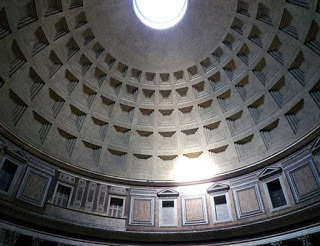
New studies of ancient concrete could teach us more about the amazing techniques of ancient Roman engineering and the secrets behind the incredible longevity of many of their concrete harbor structures.
The Secrets of Ancient Roman Concrete’s Incredible Longevity When famed Roman author Pliny the Elder described in his Naturalis Historia that concrete structures in harbors, exposed to the constant assault of the saltwater waves, become "a single stone mass, impregnable to the waves and every day stronger," he clearly didn’t lie or exaggerate. Battered by sea waves for more than two thousand years, these structures are still around today while our modern buildings erode within only a few decades.
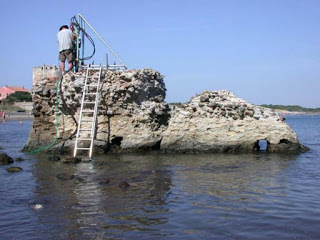
Drilling for Roman concrete samples in Tuscany, 2003. Photo Credit: J. P. Oleson
Science Alert recently reported that scientists have discovered the amazing chemistry behind this phenomenon, getting closer to revealing its long-lost recipe. From what they have noticed so far, it seems like not only was Roman concrete more durable than what we can produce today, but amazingly it gets even stronger with the passage of years.
The team of researchers led by geologist Marie Jackson from the University of Utah has been examining closely the mysteries of Roman concrete for years, and finally now they have begun mapping its crystalline structure and figuring out in detail how this ancient material becomes even more durable over time.
Modern Concrete vs Ancient Roman Concrete
Modern concrete is usually produced by portland cement, a mixture of silica sand, limestone, clay, chalk and other ingredients blended and melted together at extremely high temperatures. However, ancient Romans didn’t create their own concrete this way. They produced it from volcanic ash, lime and seawater, taking advantage of a chemical reaction they had possibly observed in naturally cemented volcanic ash deposits called tuff rocks. Blended in with the volcanic ash mortar was more volcanic rock as aggregate, which would then continue to react with the material, ultimately making Roman cement far more durable than the modern mix could ever be.
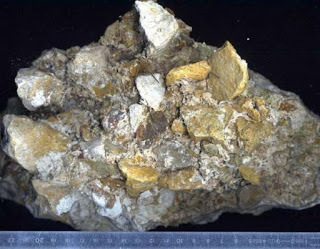
A magnified piece of Roman concrete consisting of lime, volcanic sand, and rock (Wikimedia Commons)
Modern Technology Unlocks New Doors
During Research In a previous research project led by Jackson, the team managed to collect samples of Roman marine concrete from various ports along the Italian coast. Then the researchers mapped the samples using an electron microscope, before drilling down to an extremely high resolution with X-ray micro-diffraction and Raman spectroscopy. With the help of advanced technology they managed to distinguish all the mineral grains produced in the ancient concrete over centuries. "We can go into the tiny natural laboratories in the concrete, map the minerals that are present, the succession of the crystals that occur, and their crystallographic properties. It's been astounding what we've been able to find," Jackson said as Science Alert reports.
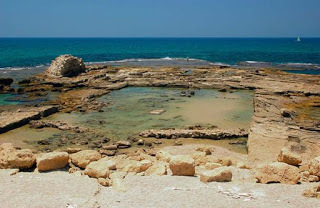
Caesarea Roman Concrete bath ruins (CC BY SA 3.0)
Jackson showed particular interest in the presence of aluminous tobermorite, a hardy silica-based mineral that is very rare and difficult to make in the lab, yet can be easily found in big doses when it comes to ancient Roman concrete. Apparently, aluminous tobermorite and a similar mineral called phillipsite appears to grow in the concrete thanks to the sea water splashing around it, gradually dissolving the volcanic ash within and giving it free room to develop a fortified structure from these interlocking crystals. "The Romans created a rock-like concrete that thrives in open chemical exchange with seawater," Jackson says, pointing out the gigantic difference of ancient and modern concrete, which in contrast to ancient Roman concrete appears to erode as saltwater rusts the steel reinforcements and washes away the compounds that hold the material together.
Could We Replicate Roman Concrete?
So, the question Jackson and her team are called to answer is if we can produce concrete today the way Romans did and how this could benefit the modern building industry. Theoretically, we could but the sad truth is that the recipes have been lost throughout the centuries. Realistically, our only chance to recreate the marvelous ancient material is to reverse-engineer it based on what we know about its chemical properties. However, that wouldn’t be easy at all as Jackson informs us, "Romans were fortunate in the type of rock they had to work with. We don't have those rocks in a lot of the world, so there would have to be substitutions made," she says as Science Alert reports, leaving a small window of hope open for the future.
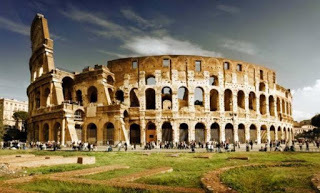
An advanced concrete recipe allowed the Romans to construct magnificent structures that no builder would dare to attempt today. Source: BigStockPhoto
It would seem to us that this creation occurred by chance but the question is open as to whether the Romans worked out their long-lasting concrete recipe by design. Either way, it is a rock-solid reminder that there is still some ancient wisdom that is so far not surpassed by the modern world.
Top image: Interior of the Roman Pantheon dome, still the largest (43.4m/142.4 ft dia.) unreinforced solid concrete dome. (CC BY NC SA 2.0)
By Theodoros Karasavvas
Published on July 11, 2017 01:00
July 10, 2017
Roman Gladiators Were War Prisoners and Criminals, Not Sporting Heroes
Ancient Origins
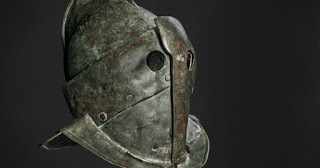
For centuries, the bloody gladiator conflicts that the Romans staged in amphitheatres throughout the empire have engrossed and repelled us. When it comes to gladiators, it is almost impossible to look away. But the arena is also the place where the Romans feel most foreign to us.
The gladiator was the product of a unique environment. He can exist only within a very particular set of religious, social, legal, political and economic circumstances. It is not surprising that this is a form of spectacle we have not seen either before or since the Romans. To acknowledge this is also to acknowledge that they are only ever going to be partially comprehensible to us.
Sadly, this is not a view shared by the Queensland Museum, which last week opened its new exhibition, Gladiators: Heroes of the Colosseum . The exhibition brings together 117 objects from Italian museums, most notably the collection of the Colosseum at Rome. Highlights include some extremely well preserved and intricately decorated gladiatorial helmets and pieces of armour from Pompeii, as well as some very fine carved reliefs depicting scenes of combat.
Yet, while the quality of the individual objects is without question and certainly worth the price of admission alone, the intellectual framework of the exhibition is far more problematic.
This is not an exhibition that is plagued by doubts or uncertainties. It firmly knows who gladiators were and what they stood for – gladiators, the opening panel of the exhibition proclaims, were the “elite athletes” of the ancient world. The antique equivalent of today’s fighters in the popular sport MMA, if you like.
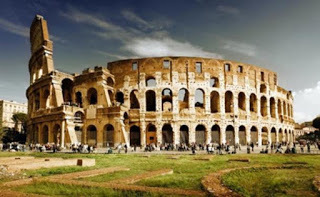
The Colosseum in Rome. Source: BigStockPhotos
Sporting analogies pepper the exhibition. Spectators are routinely referred to as “fans” and the catalogue promises that this is an exhibition that “touches on many issues that have parallels with modern day sport and sporting culture”.
At times, the exhibition also feels like it has taken its cues from contemporary videogame culture. The special weapons of the various types of gladiators are spelled out and visitors are invited to contemplate who would win between a gladiator fighting with a net (known as a retarius to the Romans) and one heavily armed ( secutor). A videogame spinoff from the exhibition is easy to imagine.
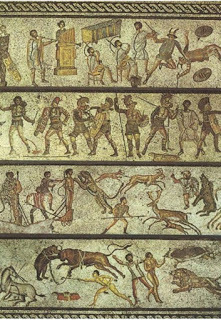
This mosaic depicts some of the entertainments that would have been offered at the games. Tripoli, Libya, first century. (Public Domain)
Rogues not heroes
Gladiatorial combat was certainly popular among the Romans. Evidence for gladiators is found in every province of the Roman Empire.
These fights initially began as contests of matched pairs as part of funeral rites honouring the dead. However, over time their popularity grew. By the time of the Roman Empire, hundreds of gladiators might be involved in spectacles that could last as long as 100 days.
These games were never just displays of gladiatorial fighting. At their most elaborate they involved beast hunts with exotic animals, the execution of criminals, naval battles staged in flooded arenas, musical entertainments and dances.
The Queensland Museum is not the first to try to understand gladiators as sporting heroes. However, it is an analogy that causes more problems than it solves.
The vast majority of gladiators were either prisoners of war or criminals sentenced to death. Gladiators were the lowest of the low; violent murderers, thieves and arsonists. Even your most badly-behaved football team at their most morally blind would have had no trouble in rejecting this crew.
Gladiators in Rome were regarded as fundamentally untrustworthy and outside of legal protection. It is more useful to think of gladiators as prisoners on death row than as David Beckham with a net and trident. The section in the exhibition where children are encouraged to dress up as gladiators would have appalled any respectable Roman parent (that said, it’s great fun).
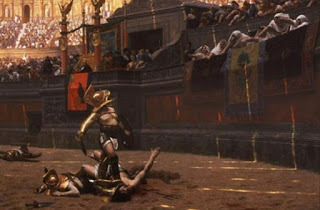
Were they really the heroes they are made out to be? Dramatic painting portraying gladiators in the arena. Jean-Léon Gérôme's 1872. Public Domain.
The Queensland Museum can’t escape the lowly, servile and criminal origins of the gladiators, but it does attempt to moderate our opinion of them by suggesting that some free citizens wilfully chose to be gladiators in search of “eternal fame and glory”. In fact, the evidence of such citizen gladiators is extremely slim. It was almost certainly extreme desperation that forced them into the arena rather than a desire to be remembered by posterity.
At another point, the exhibition suggests that the crowd saw reflected in gladiators the virtues of the soldiers who guarded the empire. Such talk would have had any self-respecting Roman legionary reaching for his short sword.
Gods and monsters
Representing gladiatorial combat as sport also inevitably underplays the religious dimension of the fighting. The exhibition includes some fabulous tomb paintings from the city of Paestum, which illustrate the origins of gladiatorial combat in the funerary rites for the dead. These are wonderful works that deserve to be much better known; however, they are a rare intrusion into an otherwise secular narrative.
Gladiatorial combats never stopped being religious events. Every day of the games would begin with a “solemn procession” with sacrifices on altars. The gladiators themselves were deeply implicated in the Roman theology of the divine, death, and the relationship between mortal and immortal. These spectacles were Roman sermons written in blood.
The final problem with focusing on gladiators as sporting heroes is that it tends to isolate their combat from the other elements that made up the games. Beast hunts and the execution of criminals were just as popular, possibly even more so. They were not precursors to the main event or entertainment for the intervals.
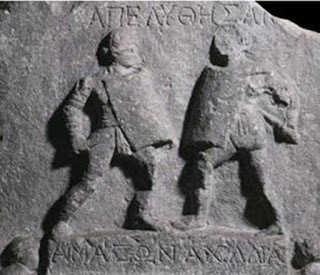
Relief of two female gladiators (gladiatrices) found at Halicarnassus. (Public Domain)
The execution of criminals could involve extravagant mythological tableaus. Prisoners were dressed as Hercules and burnt alive. The fatal flight of Icarus towards the sun might be re-enacted for the audience.
Certainly, these elaborate, gruesome affairs captured the attention of ancient writers far more than the gladiators who accompanied them. Wealthy Romans seem far more preoccupied with obtaining suitably rare fauna for their spectacles .
For the poorer members of the audience, the beast hunts had an added attraction. Often the animal meat was distributed to the audience members to take home. They were literally watching their dinner being butchered in front of them.
One of the most intriguing items in the exhibition doesn’t relate to gladiatorial combat but to one of these beast hunts. It is a second-century CE mosaic that features what appears to be a female hunter facing off a giant tiger. Who is this woman? Evidence for female hunters (like female gladiators) is practically non-existent. Is she part of some mythological tableau? A woman pretending to be an Amazon? Or a man dressed up as a woman? Is this a scene from real life at all?
She is an enigma and a worthy reminder that the real secret of the appeal of Roman combat spectacle is that it raises more questions than it answers.
Top image: The helmet of a heavily armed ‘secutor’, first century AD. Rógvi N. Johansen, Department of photo and medie Moesgaard
The article ‘ Roman Gladiators Were War Prisoners and Criminals, Not Sporting Heroes ’ by Alastair Blanshard was originally published on The Conversation and has been republished under a Creative Commons license
Published on July 10, 2017 01:00
July 9, 2017
Æthelflæd: The Anglo-Saxon Iron Lady Who Showed the Vikings No Fear
Ancient Origins
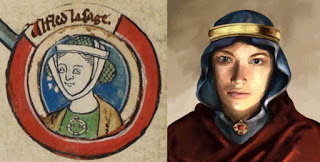
The UK now has a female prime minister and Elizabeth II has been queen for more than six decades, but few would associate Anglo-Saxon England with powerful women. Nearly 1,100 years ago, however, Æthelflæd, “Lady of the Mercians”, died in Tamworth – as one of the most powerful political figures in tenth-century Britain.
Although she has faded from English history, and is often seen as a bit-part player in the story of the making of England, Æthelflæd was in fact a hugely important figure before her death in 918, aged around 50. Indeed, the uncontested succession of her daughter, Ælfwynn, as Mercia’s leader was a move of successful female powerplay not matched until the coronation of Elizabeth I after the death of her half-sister Mary in 1558. So, while Bernard Cornwell’s novels and the BBC series The Last Kingdom are cavalier with the historical facts, perhaps they are right to give Æthelflæd a major role.

Æthelflæd as depicted in the cartulary of Abingdon Abbey (Public Domain)
Æthelflæd was born in the early 870s. Her father, Alfred “the Great” had become King of the West Saxons in 871, while her mother, Eahlswith, may have been from Mercian royal kindred. At the time, Anglo-Saxon “England” was made up of a series of smaller kingdoms, including Wessex in the south, Mercia in the Midlands and Northumbria in the far north. All faced encroachment by Viking forces that were growing in strength and ambition, as outlined in Charles Insley’s article The Strange End of the Mercian Kingdom and Mercia and the Making of England by Ian Walker.
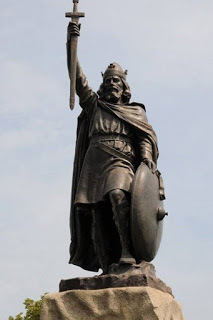
Famous statue of King Alfred the Great on Broadway in Winchester. (CC BY-SA 2.0)
Æthelflæd spent most of her life in the Kingdom of Mercia married to its de facto ruler, Æthelred. Mercia had seen some dark days by the time of her marriage. In the eighth and early ninth centuries, the Mercian kings had had good cause to consider themselves the most powerful rulers in southern Britain. But by the 870s, the kingdom had suffered dramatically from the Viking assaults which had swept across England.
One king, Burgred, had fled to Rome, and his successor, Ceolwulf II, was seen as a mere puppet by the West-Saxon compiler of the Anglo-Saxon Chronicle and disappeared between 878 and 883. Soon, the East Midlands were ruled by Scandinavians – what became known as the “Danelaw” – and so the kingdom ruled by Æthelflæd and Æthelred was by then just the western rump of the old Mercia.
Nevertheless, Æthelflæd and Æthelred together engaged in massive rebuilding projects at Gloucester, Worcester, Stafford and Chester, overseeing the refounding of churches, new relic collections and saints’ cults. Famously, in 909, the relics of the seventh-century saint, Oswald were moved from Bardney, deep in Scandinavian-controlled Lincolnshire, to a new church at Gloucester. Perhaps appropriately, for a couple facing the Vikings, Æthelflæd and her husband had a great attachment to the saint, a warrior king and Christian martyr. Æthelred was buried alongside Oswald in 911, and Æthelflæd joined him seven years later.
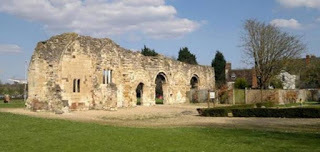
Remains of St Oswalds Priory, Gloucester, burial place of Æthelflæd and Æthelred (Public Domain)
Powerplay and Politics
At the time, Athelred and Æthelflæd did not call themselves king or queen, nor do the official documents or coins refer to them as such. Instead, they used the title “Lord/Lady of the Mercians”, because Alfred had extended his authority over Mercia and styled himself “King of the Anglo-Saxons”.
But they acted like rulers. Æthelflæd, with her husband and her brother Edward the Elder, King of the Anglo-Saxons, launched a series of military campaigns in the early tenth century. These brought all of England south of the Humber and Mersey river under Anglo-Saxon control and rolled up the Scandinavian lordships which had been established in the East Midlands and East Anglia.
These advances were backed up by an energetic programme of fortification, with burhs (fortified towns) built in places such as Bridgnorth, Runcorn, Chester and Manchester.
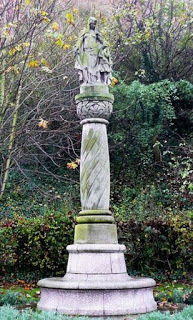
Statue in Tamworth of Æthelflæd with her nephew Æthelstan, erected in 1913 to commemorate the millennium of her fortification of the town. (Humphrey Bolton/CC BY SA 2.0)
But while she called herself a “lady”, outsiders, especially the Welsh and Irish, saw Æthelflæd as a “queen” and she surely wasn’t just her husband’s subservient wife. As Alfred the Great’s daughter, the role Mercia and the Mercians would play in the kingdom of the Anglo-Saxons was at stake.
A Potent Widow
But Æthelflæd really came into her own following her husband’s death in 911, although it seems that he had been in poor health for the best part of the previous decade. The Mercian Register in the Anglo-Saxon Chronicle, certainly celebrates her deeds from 910 onwards.
In 915, she successfully campaigned against the Welsh and the major Welsh kings, and in England she began further to expand her kingdom. In 917-8, her army took control of Viking-occupied Derby and Leicester, and just before her death, the “people of York” – that is, the Scandinavian lords of southern Northumbria – also agreed to submit to her.
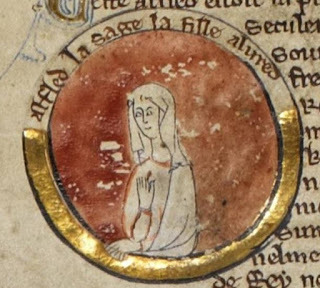
Æthelflæd. (Public Domain)
For a brief moment, she had authority not just over her own territory in Mercia, but over the Welsh, the Scandinavian East Midlands and possibly part of Northumbria, making her perhaps one of the three most important rulers in mainland Britain – the others being her brother Edward king of the Anglo-Saxons and Constantin II macAeda, King of the Scots.
This made her a major political actor in her own right, but also a respected and feared figure. Even more remarkably, she passed her authority on to her daughter, Ælfwynn, who was around 30 when her mother died. The rule of Ælfwynn in Mercia, which attracts virtually no comment at all from historians, lasted about six months before her uncle Edward launched a coup d’état, deprived her of all authority and took her into Wessex.
Æthelflæd’s legacy is enigmatic, wrapped up in the “making of England”. But she was a ruler of consequence in an era defined by male authority. Indeed, her project to rebuild the kingdom of Mercia and the Mercians might have placed midland England at the heart of later history.
Top Image: Medieval miniature of Æthelflæd in Genealogical roll of the kings of England. 14th century (Public Domain) What Aethelflad may have looked like. (History's HEROES?)
The article, originally titled ‘Æthelflæd: The Anglo-Saxon Iron Lady’ by Philip Morgan, Andrew Sargent, Charles Insley and Morn Capper was originally published on The Conversation and has been republished under a Creative Commons license.

The UK now has a female prime minister and Elizabeth II has been queen for more than six decades, but few would associate Anglo-Saxon England with powerful women. Nearly 1,100 years ago, however, Æthelflæd, “Lady of the Mercians”, died in Tamworth – as one of the most powerful political figures in tenth-century Britain.
Although she has faded from English history, and is often seen as a bit-part player in the story of the making of England, Æthelflæd was in fact a hugely important figure before her death in 918, aged around 50. Indeed, the uncontested succession of her daughter, Ælfwynn, as Mercia’s leader was a move of successful female powerplay not matched until the coronation of Elizabeth I after the death of her half-sister Mary in 1558. So, while Bernard Cornwell’s novels and the BBC series The Last Kingdom are cavalier with the historical facts, perhaps they are right to give Æthelflæd a major role.

Æthelflæd as depicted in the cartulary of Abingdon Abbey (Public Domain)
Æthelflæd was born in the early 870s. Her father, Alfred “the Great” had become King of the West Saxons in 871, while her mother, Eahlswith, may have been from Mercian royal kindred. At the time, Anglo-Saxon “England” was made up of a series of smaller kingdoms, including Wessex in the south, Mercia in the Midlands and Northumbria in the far north. All faced encroachment by Viking forces that were growing in strength and ambition, as outlined in Charles Insley’s article The Strange End of the Mercian Kingdom and Mercia and the Making of England by Ian Walker.

Famous statue of King Alfred the Great on Broadway in Winchester. (CC BY-SA 2.0)
Æthelflæd spent most of her life in the Kingdom of Mercia married to its de facto ruler, Æthelred. Mercia had seen some dark days by the time of her marriage. In the eighth and early ninth centuries, the Mercian kings had had good cause to consider themselves the most powerful rulers in southern Britain. But by the 870s, the kingdom had suffered dramatically from the Viking assaults which had swept across England.
One king, Burgred, had fled to Rome, and his successor, Ceolwulf II, was seen as a mere puppet by the West-Saxon compiler of the Anglo-Saxon Chronicle and disappeared between 878 and 883. Soon, the East Midlands were ruled by Scandinavians – what became known as the “Danelaw” – and so the kingdom ruled by Æthelflæd and Æthelred was by then just the western rump of the old Mercia.
Nevertheless, Æthelflæd and Æthelred together engaged in massive rebuilding projects at Gloucester, Worcester, Stafford and Chester, overseeing the refounding of churches, new relic collections and saints’ cults. Famously, in 909, the relics of the seventh-century saint, Oswald were moved from Bardney, deep in Scandinavian-controlled Lincolnshire, to a new church at Gloucester. Perhaps appropriately, for a couple facing the Vikings, Æthelflæd and her husband had a great attachment to the saint, a warrior king and Christian martyr. Æthelred was buried alongside Oswald in 911, and Æthelflæd joined him seven years later.

Remains of St Oswalds Priory, Gloucester, burial place of Æthelflæd and Æthelred (Public Domain)
Powerplay and Politics
At the time, Athelred and Æthelflæd did not call themselves king or queen, nor do the official documents or coins refer to them as such. Instead, they used the title “Lord/Lady of the Mercians”, because Alfred had extended his authority over Mercia and styled himself “King of the Anglo-Saxons”.
But they acted like rulers. Æthelflæd, with her husband and her brother Edward the Elder, King of the Anglo-Saxons, launched a series of military campaigns in the early tenth century. These brought all of England south of the Humber and Mersey river under Anglo-Saxon control and rolled up the Scandinavian lordships which had been established in the East Midlands and East Anglia.
These advances were backed up by an energetic programme of fortification, with burhs (fortified towns) built in places such as Bridgnorth, Runcorn, Chester and Manchester.

Statue in Tamworth of Æthelflæd with her nephew Æthelstan, erected in 1913 to commemorate the millennium of her fortification of the town. (Humphrey Bolton/CC BY SA 2.0)
But while she called herself a “lady”, outsiders, especially the Welsh and Irish, saw Æthelflæd as a “queen” and she surely wasn’t just her husband’s subservient wife. As Alfred the Great’s daughter, the role Mercia and the Mercians would play in the kingdom of the Anglo-Saxons was at stake.
A Potent Widow
But Æthelflæd really came into her own following her husband’s death in 911, although it seems that he had been in poor health for the best part of the previous decade. The Mercian Register in the Anglo-Saxon Chronicle, certainly celebrates her deeds from 910 onwards.
In 915, she successfully campaigned against the Welsh and the major Welsh kings, and in England she began further to expand her kingdom. In 917-8, her army took control of Viking-occupied Derby and Leicester, and just before her death, the “people of York” – that is, the Scandinavian lords of southern Northumbria – also agreed to submit to her.

Æthelflæd. (Public Domain)
For a brief moment, she had authority not just over her own territory in Mercia, but over the Welsh, the Scandinavian East Midlands and possibly part of Northumbria, making her perhaps one of the three most important rulers in mainland Britain – the others being her brother Edward king of the Anglo-Saxons and Constantin II macAeda, King of the Scots.
This made her a major political actor in her own right, but also a respected and feared figure. Even more remarkably, she passed her authority on to her daughter, Ælfwynn, who was around 30 when her mother died. The rule of Ælfwynn in Mercia, which attracts virtually no comment at all from historians, lasted about six months before her uncle Edward launched a coup d’état, deprived her of all authority and took her into Wessex.
Æthelflæd’s legacy is enigmatic, wrapped up in the “making of England”. But she was a ruler of consequence in an era defined by male authority. Indeed, her project to rebuild the kingdom of Mercia and the Mercians might have placed midland England at the heart of later history.
Top Image: Medieval miniature of Æthelflæd in Genealogical roll of the kings of England. 14th century (Public Domain) What Aethelflad may have looked like. (History's HEROES?)
The article, originally titled ‘Æthelflæd: The Anglo-Saxon Iron Lady’ by Philip Morgan, Andrew Sargent, Charles Insley and Morn Capper was originally published on The Conversation and has been republished under a Creative Commons license.
Published on July 09, 2017 01:30
July 8, 2017
Atlantis Unearthed – Do Surprising Underwater Scans Show Lost Architecture on the Sea Floor?
Ancient Origins
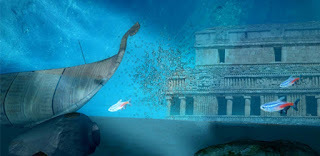
In his poems of the Iliad, the Greek Philosopher Homer introduces us to the mythical city of Troy, which remained a curiosity to many until the late 1870s when Heinrich Schliemann, on a hunch, began excavating the remains of an ancient city in Turkey. Although he was an amateur archaeologist and his methods were considered somewhat outlandish, Schliemann would evidentially find Troy and confirm its place in history.
Most historians consider Plato’s description of Atlantis, written in Timaeus, was simple story-telling as told to him by Solon, an Athenian traveler, and not a true place in Earth’s historic past. And yet, on closer inspection, we learn that Solon had heard about Atlantis from Egyptian priests who described the true antiquity of Earth and civilizations that had come and gone in the distant past.
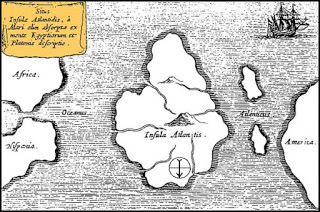
Athanasius Kircher's map of Atlantis from Mundus Subterraneus (1669) drawn with south at the top. (Public Domain)
Advanced Ancient Society
Down through the ages, Atlantis has captured the imaginations of countless authors and investigators, and today is considered a fable and described in negative or pseudo-scientific terms by conventional scientists. But dismissing Atlantis is a mistake, and the evidence of very old and highly advanced people in the Americas and other parts of the world are important to consider.
It’s difficult for us to imagine a great culture which existed over 10,000 years ago and the contributions they might have made to the world, and yet for those who live in or have visited Mexico, they know there are countless examples of very old, anomalous buildings and pyramid complexes constructed with an engineering prowess that is lost in time; the Maya are a classic example. Although we know very little of their history, their mathematics, engineering, and other sciences were highly advanced, without obviously known periods of development. It’s as if they appeared magically complete, with all their advances and characteristics of a complex society in place from day one.
Because of the tragic destruction of hundreds of Maya codices, technical manuals and records of their history, we are left to wonder at the evolution of this fascinating culture.
The Sleeping Prophet – Edgar Cayce
As the host of the popular podcast Earth Ancients, a program that investigates Earth’s ancient history, I’ve been fortunate to interview many of today’s most gifted authors, researchers, investigators, and scientists. Atlantis has been a theme covered on numerous occasions, as well as its probable influence on other cultures around the world. Invariably when the subject of Atlantis is broached, and the great psychic Edgar Cayce comes up for discussion.
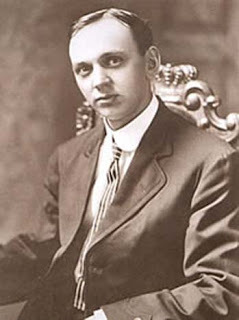
Edgar Cayce in October 1910, when this photograph appeared on the front page of The New York Times. (Public Domain)
Known to many as the Sleeping Prophet, Cayce was an American trans-channel, who in the 1920s to 1940s claimed to be able to access a level of consciousness which could view the lives of an individual through their many incarnations on earth. In these readings, Cayce was said to travel to a certain lifetime and describe traumas, injuries or other conditions which were affecting the wellness of a person in the present time. Hundreds of these readings were said to have occurred during a period when the continent of Atlantis was in the Atlantic Ocean. During the readings, Cayce also described a highly advanced technology which was developed around piezoelectric science and that powered flying machines, land and submarine craft, as well as a variety of devices and weapons.
When asked about the location of Atlantis, Cayce described it as having had three distinct periods: 100,000+ years, 28,000 years, and roughly 12,000 years ago—each phase of land change resulting from terrible earthquakes and land shifts. He said one of the great cities of Atlantis, Poseidia, was positioned in the Caribbean Ocean, in what is present day Bimini Islands. In 1940, Cayce predicted that Poseidia would re-emerge again in the late 1960s, complete with its temples and other buildings.
During his lifetime, Cayce and his followers built an organization around his readings which included a hospital. Association for Research and Enlightenment (ARE) was formed to house the thousands of hours of readings, develop numerous health remedies, and to provide an institution for higher learning. Over the years, a number of people have searched for the remains of Atlantis only to fall short in their expectations.
Following the Underwater Trail
In 1998 and again in 2007, ARE funded underwater research on target areas which had been discovered using the latest satellite and airplane imagery. Following the path of the immense Bimini wall, a massive series of underwater stones which formed a road that may have been part of an ancient harbor, archaeologist William Donato, with Michael Pateman and a team of sonar scanning technicians, made a startling discovery.
On the Target 1 sonar imagery, at approximately 130 feet (40 meters) underwater, what seems to be a series of buildings were visible that are similar to those found in the Yucatan Peninsula. One series (pictured in never-before-published images below), is similar in style to the Puuc Maya pyramid complexes found on the Gulf of Mexico side of the Peninsula. When side-scanning sonar results are introduced, we can see the complete front facade of a series of buildings, including staircases, doorways, and columns.
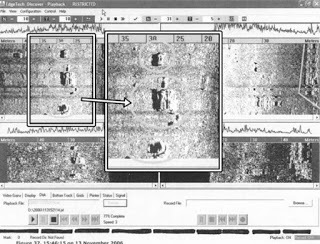
Underwater scanned image of structures off the coast of Bimini. (Image provided by William Donato).
When I interviewed William Donato, he mentioned that at the time that he was surprised at the style of the pyramids in the color scans, as well as its similarity to Maya-style complexes. Further investigation would be ideal, but because of funding issues and the great expense of using underwater scanning equipment, follow-up dives have not taken place.
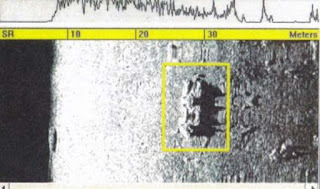
Building complex similar to Maya buildings in Yucatan Mexico. Image scanned at approximately 130 feet under the ocean off the coast of Bimini. (Image provided by William Donato).
Civilizations Destroyed
Some people might suggest that these are Maya cities and that there never was an Atlantis. The issue with this theory is that these buildings are deep under water—in some places over 300 feet (91 meters) deep—which could suggest rising water levels. Scientists now understand that following the end of the last ice age (the Pleistocene epoch), Earth encountered a traumatic event approximately 12,000 years ago, when a series of asteroids bombarded our planet and changed surface features, elevated the surface temperature, and destroyed a vast number of civilizations and animals. This event is now called the Younger Dryas period and is considered by many to be a cause for the rise of the world’s oceans. If we compare this event with Cayce’s description of the destruction of Atlantis, the two are eerily similar.
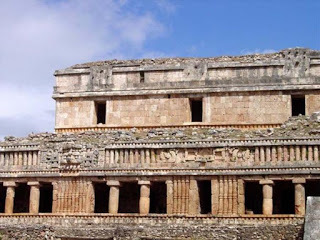
Puuc-style architecture of the Maya: ruins of the Palace of Sayil, Yucatan. (Rose Vekony/CC BY-SA 3.0)
The destruction of Atlantis and civilizations of planet Earth may have been caused by devastating land changes that caused huge areas to be submerged, massive tsunamis to cover land, and flooding to deluge large portions of the planet.
Surprising Connection to the Maya
For me, it does provide compelling evidence that the Maya may have been the descendants of a scientifically robust civilization that suddenly vanished. When I see the underwater scans of Bimini I’m reminded of the building complexes I’ve visited in Yucatan and other regions of Mexico. There’s something about the construction that appears to be lost in time, and it would explain why there is no early developmental period of the Maya that we find today. Their science, engineering, construction techniques, medicine, mathematics and so much more were inherited from a mother culture formed after thousands of years of research and development.

Side sonar scan off the coast of Bimini at 130 feet under the water. This color image reveals the staircases, doors, and the roof of a pyramid complex. (Image provided by William Donato and ARE)
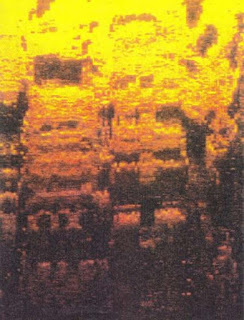
Side sonar scan of a pyramid complex off the Bimini coast. Depth is over 100 feet. (Images provided by William Donato and ARE).
To this day, it’s my belief and conviction that our best link to the ancient past is within the Maya civilization, and what they encoded for us in their buildings, artwork and other artifacts. I also believe that what some see and interpret as the Maya people (savage, bloodthirsty, warring people) were the surviving generations who struggled to begin again after the great deluge and earth change. The scientists, engineers, and great planners perished, leaving the few remaining people to kick-start civilization. We may be discovering this today at many Maya cities throughout Central America, as scientists excavating standing buildings have uncovered very early settlements and construction just below the surface. It’s also interesting to note that some of the earliest pyramid complexes are the most sophisticated, revealing an engineering and construction prowess that is lost in later years.
Does this prove that Atlantis was real? You can be the judge of this possibility by listening to the podcast, “ Atlantis Unearthed ,” which aired June 17, 2017, on the Earth Ancients podcast. www.earthancients.com
Cliff Dunning is host/producer the popular podcast, Earth Ancients : Startling new discoveries from our planet's distant past. His newest book, The Black Knight Satellite will be released in fall 2017. --
Top Image: Underwater World ( Public Domain ) and ruins of the Palace of Sayil, Yucatan. (Rose Vekony/ CC BY-SA 3.0 ); Deriv
By Cliff Dunning

In his poems of the Iliad, the Greek Philosopher Homer introduces us to the mythical city of Troy, which remained a curiosity to many until the late 1870s when Heinrich Schliemann, on a hunch, began excavating the remains of an ancient city in Turkey. Although he was an amateur archaeologist and his methods were considered somewhat outlandish, Schliemann would evidentially find Troy and confirm its place in history.
Most historians consider Plato’s description of Atlantis, written in Timaeus, was simple story-telling as told to him by Solon, an Athenian traveler, and not a true place in Earth’s historic past. And yet, on closer inspection, we learn that Solon had heard about Atlantis from Egyptian priests who described the true antiquity of Earth and civilizations that had come and gone in the distant past.

Athanasius Kircher's map of Atlantis from Mundus Subterraneus (1669) drawn with south at the top. (Public Domain)
Advanced Ancient Society
Down through the ages, Atlantis has captured the imaginations of countless authors and investigators, and today is considered a fable and described in negative or pseudo-scientific terms by conventional scientists. But dismissing Atlantis is a mistake, and the evidence of very old and highly advanced people in the Americas and other parts of the world are important to consider.
It’s difficult for us to imagine a great culture which existed over 10,000 years ago and the contributions they might have made to the world, and yet for those who live in or have visited Mexico, they know there are countless examples of very old, anomalous buildings and pyramid complexes constructed with an engineering prowess that is lost in time; the Maya are a classic example. Although we know very little of their history, their mathematics, engineering, and other sciences were highly advanced, without obviously known periods of development. It’s as if they appeared magically complete, with all their advances and characteristics of a complex society in place from day one.
Because of the tragic destruction of hundreds of Maya codices, technical manuals and records of their history, we are left to wonder at the evolution of this fascinating culture.
The Sleeping Prophet – Edgar Cayce
As the host of the popular podcast Earth Ancients, a program that investigates Earth’s ancient history, I’ve been fortunate to interview many of today’s most gifted authors, researchers, investigators, and scientists. Atlantis has been a theme covered on numerous occasions, as well as its probable influence on other cultures around the world. Invariably when the subject of Atlantis is broached, and the great psychic Edgar Cayce comes up for discussion.

Edgar Cayce in October 1910, when this photograph appeared on the front page of The New York Times. (Public Domain)
Known to many as the Sleeping Prophet, Cayce was an American trans-channel, who in the 1920s to 1940s claimed to be able to access a level of consciousness which could view the lives of an individual through their many incarnations on earth. In these readings, Cayce was said to travel to a certain lifetime and describe traumas, injuries or other conditions which were affecting the wellness of a person in the present time. Hundreds of these readings were said to have occurred during a period when the continent of Atlantis was in the Atlantic Ocean. During the readings, Cayce also described a highly advanced technology which was developed around piezoelectric science and that powered flying machines, land and submarine craft, as well as a variety of devices and weapons.
When asked about the location of Atlantis, Cayce described it as having had three distinct periods: 100,000+ years, 28,000 years, and roughly 12,000 years ago—each phase of land change resulting from terrible earthquakes and land shifts. He said one of the great cities of Atlantis, Poseidia, was positioned in the Caribbean Ocean, in what is present day Bimini Islands. In 1940, Cayce predicted that Poseidia would re-emerge again in the late 1960s, complete with its temples and other buildings.
During his lifetime, Cayce and his followers built an organization around his readings which included a hospital. Association for Research and Enlightenment (ARE) was formed to house the thousands of hours of readings, develop numerous health remedies, and to provide an institution for higher learning. Over the years, a number of people have searched for the remains of Atlantis only to fall short in their expectations.
Following the Underwater Trail
In 1998 and again in 2007, ARE funded underwater research on target areas which had been discovered using the latest satellite and airplane imagery. Following the path of the immense Bimini wall, a massive series of underwater stones which formed a road that may have been part of an ancient harbor, archaeologist William Donato, with Michael Pateman and a team of sonar scanning technicians, made a startling discovery.
On the Target 1 sonar imagery, at approximately 130 feet (40 meters) underwater, what seems to be a series of buildings were visible that are similar to those found in the Yucatan Peninsula. One series (pictured in never-before-published images below), is similar in style to the Puuc Maya pyramid complexes found on the Gulf of Mexico side of the Peninsula. When side-scanning sonar results are introduced, we can see the complete front facade of a series of buildings, including staircases, doorways, and columns.

Underwater scanned image of structures off the coast of Bimini. (Image provided by William Donato).
When I interviewed William Donato, he mentioned that at the time that he was surprised at the style of the pyramids in the color scans, as well as its similarity to Maya-style complexes. Further investigation would be ideal, but because of funding issues and the great expense of using underwater scanning equipment, follow-up dives have not taken place.

Building complex similar to Maya buildings in Yucatan Mexico. Image scanned at approximately 130 feet under the ocean off the coast of Bimini. (Image provided by William Donato).
Civilizations Destroyed
Some people might suggest that these are Maya cities and that there never was an Atlantis. The issue with this theory is that these buildings are deep under water—in some places over 300 feet (91 meters) deep—which could suggest rising water levels. Scientists now understand that following the end of the last ice age (the Pleistocene epoch), Earth encountered a traumatic event approximately 12,000 years ago, when a series of asteroids bombarded our planet and changed surface features, elevated the surface temperature, and destroyed a vast number of civilizations and animals. This event is now called the Younger Dryas period and is considered by many to be a cause for the rise of the world’s oceans. If we compare this event with Cayce’s description of the destruction of Atlantis, the two are eerily similar.

Puuc-style architecture of the Maya: ruins of the Palace of Sayil, Yucatan. (Rose Vekony/CC BY-SA 3.0)
The destruction of Atlantis and civilizations of planet Earth may have been caused by devastating land changes that caused huge areas to be submerged, massive tsunamis to cover land, and flooding to deluge large portions of the planet.
Surprising Connection to the Maya
For me, it does provide compelling evidence that the Maya may have been the descendants of a scientifically robust civilization that suddenly vanished. When I see the underwater scans of Bimini I’m reminded of the building complexes I’ve visited in Yucatan and other regions of Mexico. There’s something about the construction that appears to be lost in time, and it would explain why there is no early developmental period of the Maya that we find today. Their science, engineering, construction techniques, medicine, mathematics and so much more were inherited from a mother culture formed after thousands of years of research and development.

Side sonar scan off the coast of Bimini at 130 feet under the water. This color image reveals the staircases, doors, and the roof of a pyramid complex. (Image provided by William Donato and ARE)

Side sonar scan of a pyramid complex off the Bimini coast. Depth is over 100 feet. (Images provided by William Donato and ARE).
To this day, it’s my belief and conviction that our best link to the ancient past is within the Maya civilization, and what they encoded for us in their buildings, artwork and other artifacts. I also believe that what some see and interpret as the Maya people (savage, bloodthirsty, warring people) were the surviving generations who struggled to begin again after the great deluge and earth change. The scientists, engineers, and great planners perished, leaving the few remaining people to kick-start civilization. We may be discovering this today at many Maya cities throughout Central America, as scientists excavating standing buildings have uncovered very early settlements and construction just below the surface. It’s also interesting to note that some of the earliest pyramid complexes are the most sophisticated, revealing an engineering and construction prowess that is lost in later years.
Does this prove that Atlantis was real? You can be the judge of this possibility by listening to the podcast, “ Atlantis Unearthed ,” which aired June 17, 2017, on the Earth Ancients podcast. www.earthancients.com
Cliff Dunning is host/producer the popular podcast, Earth Ancients : Startling new discoveries from our planet's distant past. His newest book, The Black Knight Satellite will be released in fall 2017. --
Top Image: Underwater World ( Public Domain ) and ruins of the Palace of Sayil, Yucatan. (Rose Vekony/ CC BY-SA 3.0 ); Deriv
By Cliff Dunning
Published on July 08, 2017 01:30
July 7, 2017
Mysterious gravestones near Pompeii reflect political upheaval in Ancient Rome
IB Times
By Léa Surugue

On the outskirts of Pompeii, hundreds of mysterious stelae (gravestones), shaped in a very unusual way, can be found. Known as columelle (from the Latin meaning 'small column'), they are rectangular standing stones topped with disks almost resembling human busts – and they have long puzzled archaeologists.
The city of Pompeii, best known for the massive volcanic eruption of Mount Vesuvius in 79 AD which buried it under ash, was incorporated into the Roman state in the early 1st century BCE, along with other cities of southern Campania (south of the Bay of Naples). This happened after a bitter Social War fought between Rome and its former allies in Italy, from 91 to 88 BCE.
Because columelle are so different to the kind of stelae that have been documented in Rome from the same period, archaeologists have previously argued that these gravestones must pre-date Roman times.
They have described them as objects that were unique to the funerary culture and belief system of Pompeii and its neighbours, saying that they were first created when these cities were independent from Rome.
However, analyses have revealed that the earliest known columelle were erected no earlier than the mid-1st century BCE, after Pompeii had already been conquered by Rome.
This paradox is intriguing to archaeologists, who have attempted to learn more about the origins and purpose of columelle, and why they emerged in Roman times. A lot of research has been done to find out how they were used, but little has been done to study them in the broader Roman context.
In a study now published by the American Journal of Archaeology, Allison Emmerson, from the Faculty of Classical Studies at Tulane University (USA), puts forward new hypotheses to solve the puzzle of what the columelle meant to the people of Southern Campania and why they appear older than they really are.
Unique cultural identity
In the pre-Roman period, the cities south of the Bay of Naples are thought to have been culturally distinct from the rest of Italy.
The aftermath of the Social War was characterised by great social and political upheaval. The entire Italian peninsula, including those cities, were for the first time all united under Rome, putting this unique culture in peril.
Emmerson argues that columelle were not pre-Roman objects which were then carried into the Roman era – as many other scholars had previously said. Instead, she writes that columelle began appearing around Pompeii and other southern cities early after the unification of the peninsula with a specific purpose
"The unification of the cities under Rome brought major shifts in the way Italians thought about themselves and each other. One reaction to the change was that Italian cities and regions — now politically and culturally united for the first time — began to emphasise their individual histories," Emmerson told IBTimes UK.
Columelle often marked one burial within a larger group tomb - usually the tomb of a single family, including their slaves. Their shape, so similar to that of a human bust, is much simpler than that of other gravestones from the same period, and as such, columelle appear to date back to more ancient times.
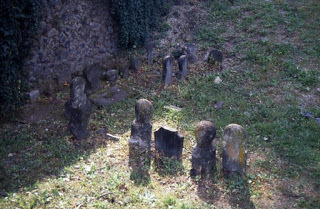
Strange gravestones were recovered near Pompeii. They are known as columelle.Peter Stewart/Flickr Creative commons
But Emmerson's research suggests that columelle were not as old as they might seem. Since none dating back to pre-Roman times have been discovered, there seems to be little evidence to say they formed part of a funerary culture unique to Pompeii and neighbouring cities before the Social War.
Rather, these gravestones erected after the war, seem to be a sort of political statement to show the rest of the Peninsula that these cities were unique, despite having been integrated into the Roman state. "
As often happens in times when humans look back to the 'good old days' that process brought with it some exaggeration, reimagining, and even invention of the past. Basically, they wanted to emphasize aspects of their culture that made them distinct. The evidence suggests that columelle, like other objects and traditions that appeared at the same time, were meant to seem old, but were actually new," Emmerson added.
According to her, there might have been even more reason to come up with objects such as columelle to create the image of an age old, unified region. The largest and most important city, Nuceria of southern Campania, had indeed sided with Rome in the Social War, unlike all the others. "So the columelle almost try to delete that recent history, glossing over what must have been bitter divisions between the people of the region," Emmerson said.
By Léa Surugue

On the outskirts of Pompeii, hundreds of mysterious stelae (gravestones), shaped in a very unusual way, can be found. Known as columelle (from the Latin meaning 'small column'), they are rectangular standing stones topped with disks almost resembling human busts – and they have long puzzled archaeologists.
The city of Pompeii, best known for the massive volcanic eruption of Mount Vesuvius in 79 AD which buried it under ash, was incorporated into the Roman state in the early 1st century BCE, along with other cities of southern Campania (south of the Bay of Naples). This happened after a bitter Social War fought between Rome and its former allies in Italy, from 91 to 88 BCE.
Because columelle are so different to the kind of stelae that have been documented in Rome from the same period, archaeologists have previously argued that these gravestones must pre-date Roman times.
They have described them as objects that were unique to the funerary culture and belief system of Pompeii and its neighbours, saying that they were first created when these cities were independent from Rome.
However, analyses have revealed that the earliest known columelle were erected no earlier than the mid-1st century BCE, after Pompeii had already been conquered by Rome.
This paradox is intriguing to archaeologists, who have attempted to learn more about the origins and purpose of columelle, and why they emerged in Roman times. A lot of research has been done to find out how they were used, but little has been done to study them in the broader Roman context.
In a study now published by the American Journal of Archaeology, Allison Emmerson, from the Faculty of Classical Studies at Tulane University (USA), puts forward new hypotheses to solve the puzzle of what the columelle meant to the people of Southern Campania and why they appear older than they really are.
Unique cultural identity
In the pre-Roman period, the cities south of the Bay of Naples are thought to have been culturally distinct from the rest of Italy.
The aftermath of the Social War was characterised by great social and political upheaval. The entire Italian peninsula, including those cities, were for the first time all united under Rome, putting this unique culture in peril.
Emmerson argues that columelle were not pre-Roman objects which were then carried into the Roman era – as many other scholars had previously said. Instead, she writes that columelle began appearing around Pompeii and other southern cities early after the unification of the peninsula with a specific purpose
"The unification of the cities under Rome brought major shifts in the way Italians thought about themselves and each other. One reaction to the change was that Italian cities and regions — now politically and culturally united for the first time — began to emphasise their individual histories," Emmerson told IBTimes UK.
Columelle often marked one burial within a larger group tomb - usually the tomb of a single family, including their slaves. Their shape, so similar to that of a human bust, is much simpler than that of other gravestones from the same period, and as such, columelle appear to date back to more ancient times.

Strange gravestones were recovered near Pompeii. They are known as columelle.Peter Stewart/Flickr Creative commons
But Emmerson's research suggests that columelle were not as old as they might seem. Since none dating back to pre-Roman times have been discovered, there seems to be little evidence to say they formed part of a funerary culture unique to Pompeii and neighbouring cities before the Social War.
Rather, these gravestones erected after the war, seem to be a sort of political statement to show the rest of the Peninsula that these cities were unique, despite having been integrated into the Roman state. "
As often happens in times when humans look back to the 'good old days' that process brought with it some exaggeration, reimagining, and even invention of the past. Basically, they wanted to emphasize aspects of their culture that made them distinct. The evidence suggests that columelle, like other objects and traditions that appeared at the same time, were meant to seem old, but were actually new," Emmerson added.
According to her, there might have been even more reason to come up with objects such as columelle to create the image of an age old, unified region. The largest and most important city, Nuceria of southern Campania, had indeed sided with Rome in the Social War, unlike all the others. "So the columelle almost try to delete that recent history, glossing over what must have been bitter divisions between the people of the region," Emmerson said.
Published on July 07, 2017 01:30



